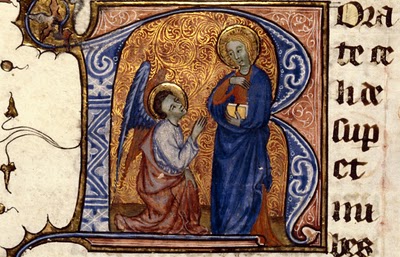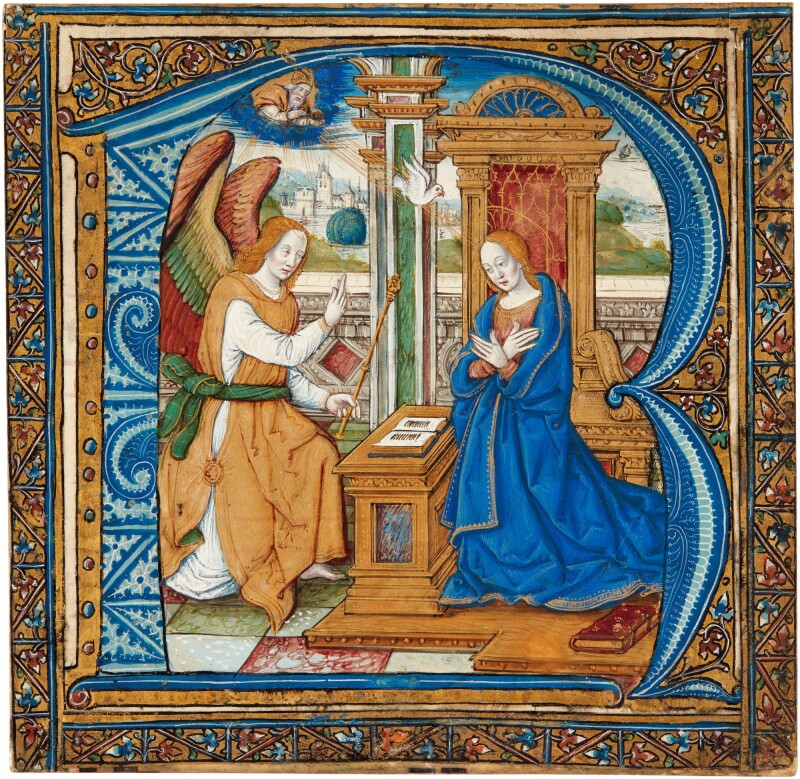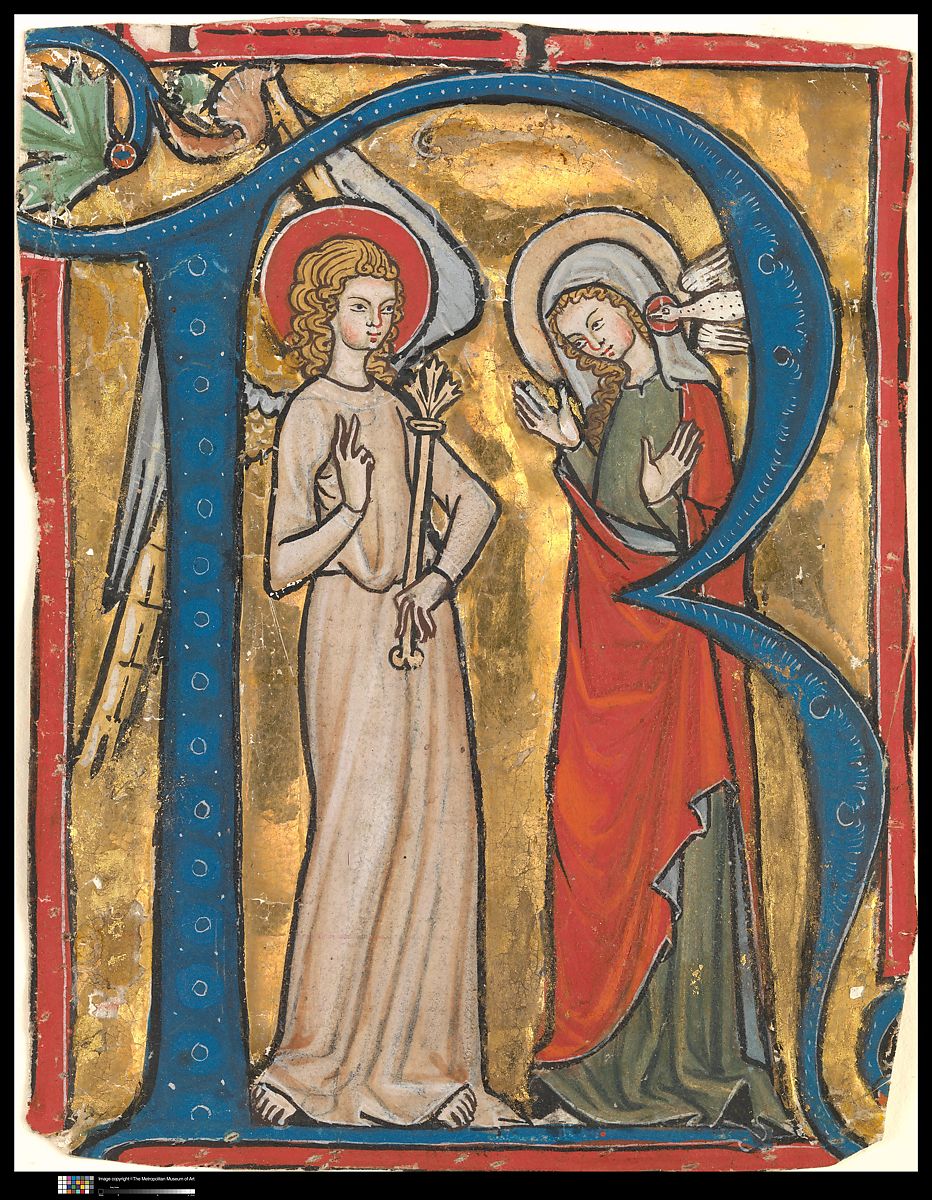 In the old Julian calendar before the Gregorian reform, 13 December was about the darkest day of the year (= Greg 26 Dec).
In the old Julian calendar before the Gregorian reform, 13 December was about the darkest day of the year (= Greg 26 Dec).
Hence, St. Lucy, whose name is from the Latin lux… “light”, reminds us who dwell in the still darkening Northern Hemisphere that our days will soon be getting longer again. She was much venerated at this time of year.
Do you remember the little mnemonic poems? “Lenty, Penty, Crucy, Lucy”, or else
“Fasting days and Emberings be
Lent, Whitsun, Holyrood, and Lucie.”
The Wednesday, Friday and Saturday after St. Lucy are the Advent Ember Days.
This week we observe, after St. Lucy, the Advent Ember Days. Ember Wednesday of Advent had the tradition of celebrating the Missa Aurea, or Golden Mass, so-called because in ancient illuminated missals and sacramentaries the initial capitals were in gold. It was once a strong custom, in the Middle Ages, and then it faded away only to be revived with the 1960 reforms. And now certain people are trying to suppress again that which has always been sacred and great.
All the more reason to do it up big and do it up right. Molon labe.
 Missa aurea also refers to little dramas in medieval times in which the Annunciation was acted out. It is thus not just “golden Mass” but “the golden sending“, which of course refers to the moment in which Our Lord becomes incarnate in the womb of the Virgin and His work for our salvation begins a new phase. The first words of the Gospel for this day are “Missus est angelus…“. So, missus… missa… etc.
Missa aurea also refers to little dramas in medieval times in which the Annunciation was acted out. It is thus not just “golden Mass” but “the golden sending“, which of course refers to the moment in which Our Lord becomes incarnate in the womb of the Virgin and His work for our salvation begins a new phase. The first words of the Gospel for this day are “Missus est angelus…“. So, missus… missa… etc.
Missa aurea comes to be used in the terminology of art history also for paintings of the Annunciation, which often contain dramatic elements associated with the tableaux struck in the dramatic presentations of the mystery. Doves would be lowered and an old man would be placed in a loft wearing an alb and cope. Angels would come vested in dalmatics.
The Arena or Scrovegni Chapel in the 13th c. Giotto’s frescoes echo this tradition as do many paintings of the Annunciation.
In nature in the Northern Hemisphere, we are in the shortest days and longest nights. Frankly, I long for the longer days. Imagine how people longed for the light before they had electricity. The longing we have for the calendar to move, the Earth to whiz faster toward longer days, is a parallel for our longing for the Lord to come. He is Light from Light. The 1st Collect for Ember Wednesday speaks to this impatience: read it aloud and listen for the urgency within the threefold “command” we are issuing to the Lord (festina… ne tardaveris… impende).
COLLECT:
Festina quaesumus, Domine, ne tardaveris,
et auxilium nobis supernae virtutis impende;
ut adventus tui consolationibus subleventur,
qui in tua pietate confidunt.
This Collect, an ancient prayer found in such manuscripts as the 8th c. Liber sacramentorum Gellonensis, survived the snipping and pasting experts of Fr. Bugnini’s Consilium in a somewhat truncated form, to be prayed on 24 December in the Novus Ordo: Festina, quaesumus, ne tardaveris, Domine Iesu, ut adventus tui consolationibus subleventur, qui in tua pietate confidunt.
That form tardaveris is a perfect subjunctive of tardo, “to tarry, loiter, linger, delay”, paired here with ne to form a kind of imperative. That ne tardaveris is found in the Latin version of the Psalms.
Impendo is “to expend, devote, employ, apply”. Pietas, when it refers to man has to do with “duty”, but when applied to God, it becomes “mercy… pity”. Remember that adventus here is a genitive with tui. Sublevo means, basically, “to lift up from beneath, to raise up, hold up, support”, but it comes to mean, “to sustain, support, assist, encourage, console any one in misfortune”. The perfect way to describe this vale of tears in which we journey.
LITERAL VERSION:
Hurry, we beseech You, O Lord, tarry not,
and expend upon us the help of heavenly power;
that those who rely upon Your mercy
may be sustained by the consolations of Your Coming.
You can feel in this prayer the growing Christian sense of urgency and longing. Advent seems to pick up speed and become more anxious for resolution as we plunge headlong into physical darkness and cold, the reminders of our inevitable appointment with death.
This oration looks simultaneously back to the Nativity of the Eternal Word made man, but also forward to the Second Coming, which gives us consolation. Christians in the state of grace can feel great consolation at the thought of the Coming of the Lord, in history and in the time to come. We need not be afraid when we are in the state of grace. Therefore, the Christian always eagerly says “Come, Lord Jesus. Maranatha. Come.”
This prayers rings with consolation.
May the Lord’s coming and promise of return console any of you who are burdened with sorrow. Many people feel at times inconsolable.
This time of year can be a annual trial of despair and sadness for so many who are alone and suffering.
In gratitude for the Lord’s promises, console others.
Think of this as a “golden rule”.



































Pingback: Our Rich Traditions of Ember Wednesday of Advent – The Missa Aurea, Golden Mass – Via Nova Media
Such a beautiful exposition! Thank you father!
Ah the Incarnation and the Nativity. Interesting stuff there Father.
I wonder if more attention was paid to the Incarnation [Word made Flesh] and the Nativity [Word made visible], more would understand why contraception is so evil, more evil than abortion and the root of many evils!
Makes ya wonder if there is a correlation to the insensitivity to contraception [and all Onanisms] because the Angelus is no longer said, where we stop everything three times a day and meditate on the Word unseen, but incarnated. Planned from the Beginning.